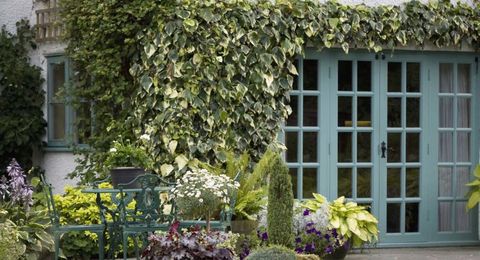Will Lead Hurt Garden Plants
Ideal for small gardens as they take up virtually no space on the ground, climbing plants can help disguise eyesores and soften fences or walls, as well as providing year-round greenery, flowers, scent and even fruit.
MAKE THE RIGHT CHOICE

Getty Images
You can find climbing plants to suit virtually any space. In fact the choice can seem overwhelming. To narrow it down, think about your plot and how you want it to look.
- Both evergreen and deciduous climbers are available, so decide if you would prefer year-round green cover or a plant that will drop its leaves in winter. The four common evergreen climbers are ivy, Clematis armandii, passionflower and, for a sheltered spot, star jasmine.
- When it comes to shade or sun, there are not so many shade lovers to choose from: ivy, climbing hydrangea, Clematis armandii and some roses.
- Finally, decide whether you want a plant that will attach itself, called self-clinging, or one that needs wires or a trellis to climb up. It's tempting to go for a climber that sorts itself out, but it's more difficult to keep these under control and their suckers can damage mortar, especially on old walls. If you did want a self-clinger, ivy, Boston ivy, Virginia creeper and climbing hydrangea are the main ones.
PLANTING UP

Getty Images
You can plant out a container-grown climber at any time of the year as long as it's able to get water, so avoid very cold spells when the ground is frozen solid. Once the weather heats up, your climbing plants will need regular watering. One of the main reasons to worry about watering these plants is because walls and other structures often have a rain- shadow – an area of a foot or so around them that doesn't get a lot of rain. The solution is to plant your climber a little further away from the wall than you might think and tilt it at a slight angle, pointing the stems towards the wall. You might then have to help your plant 'find' the wall as it starts to grow.
KEEPING IT NEAT

Getty Images
Once your climbing plants are established, make sure they don't get out of control with a yearly trim.
- If it's a plant grown for its flowers (roses, wisteria, honeysuckle), cut it back immediately after it flowers.
- If it's grown for its fruit or colourful autumn leaves (such as a wall-trained apple or Boston ivy), prune it in autumn after it has fruited or the leaves have finished.
- Most climbers (unlike many shrubs) are happy to be chopped back hard. Clematis, roses, wisteria and ivy all usually respond well to being cut back even to within 30cm of the ground, but be a bit more careful with honeysuckle, jasmine and Boston ivy as they won't re-sprout if cut too far down. Leave them with at least 60cm of stem to regrow.
- If you really love the plant and don't want to risk its survival, cut it back gradually over a few years. Each year prune it by one third; that way you can be sure it will re-sprout before continuing.
- Keep in mind the best time to prune. It can be done whenever the plant will get sunshine and lots of water to help it grow again. Using a general fertiliser after any pruning is a good idea in order to replace nutrients in the soil and encourage the plant's re-growth.
EASY CLIMBERS

Getty Images
These are varieties for every corner of the garden.
FOR SHADE: Self-clinging - climbing hydrangea and ivy. Not self-clinging -Clematis armandii and some roses such as Mme Alfred Carrière.
FOR THE SUN: Self-clinging - Boston ivy and Virginia creeper. Not self-clinging - Roses,
passionflower, wisteria,
clematis.
This content is created and maintained by a third party, and imported onto this page to help users provide their email addresses. You may be able to find more information about this and similar content at piano.io
Will Lead Hurt Garden Plants
Source: https://www.housebeautiful.com/uk/garden/plants/advice/a530/how-to-find-the-perfect-climbing-plants/
Posted by: lairdobler1999.blogspot.com

0 Response to "Will Lead Hurt Garden Plants"
Post a Comment